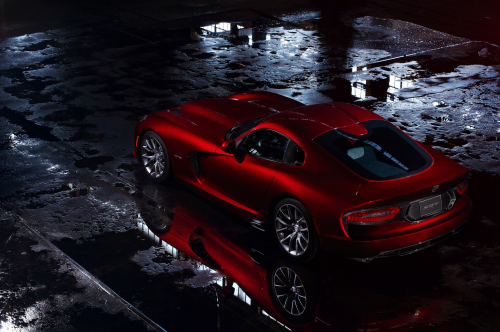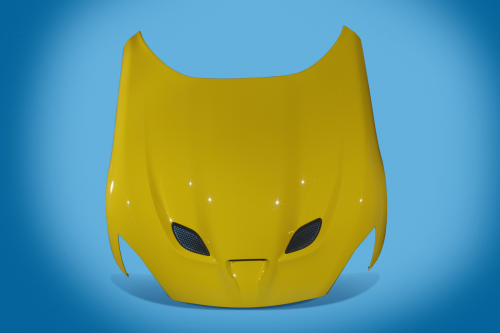

The Vehicle Engineering Team Award (VETA) recognises the technical achievements of entire teams comprised of automotive designers and engineers, tier integrators, materials suppliers, tool makers, and others whose work – in research, design, engineering and/or manufacturing – has led to significant integration of polymeric materials on a notable vehicle.
The Viper and composites
"The Viper has a long tradition of raising the bar on plastics and composites innovation," explains Mike Shinedling, Viper engineering launch manager, SRT Engineering, at Chrysler Group.
"Historically, Vipers have been 'bare-bones/no-frills' sports cars, something that was acceptable to our most ardent, hard-core customers, but not all potential buyers appreciated. In fact, many loyal Viper customers had been requesting more amenities and features on our next vehicle and I'm happy to say our team rose to the challenge. The new 2013 SRT Viper is a performance machine that takes a quantum leap forward by offering world-class levels of feature content, interior trim, and exterior finish, and it does so at a significant weight savings."
"Plastics and composites were key enablers in creating our most outstanding vehicle to date while directly lowering vehicle mass approximately 100 lbs (45 kg)," he says.
Key composites features
Key features of the new Viper vehicle directly enabled by composite materials include:
- Extensive use of composites on exterior body panels (representing more than 50% of the vehicle's skin): carbon fibre/epoxy prepreg (visible fabric weave on surface from Umeco plc/Cytec Industries and unidirectional structural layers from Toray Carbon Fibers Americas Inc) were used for the clamshell hood/fender module as well as the structural roof (which meets Federal requirements for roof crush) and liftgate. Plasan Carbon Composites manufactured the parts using vacuum bag/autoclave cure. Inner and outer panels are bonded with structural polyurethane (PUR) adhesives from Dow Automotive (roof) and Ashland Inc (hood/fenders and liftgate). Exterior panels are all painted, but hood and liftgate inner panels feature polished, exposed-weave carbon composite. Replacing previous sheet moulding compound (SMC) and metal provided a mass savings of 73 lbs (33 kg), a 43% weight reduction on equivalent parts on the previous Viper car, helping the team lower the vehicle's centre of gravity, which in turn improves handling and cornering, and improves stability during braking.
- Composite windshield frame: SMC (glass and carbon fibre reinforced polyester) was used to compression mould the vehicle's front windshield frame/surround. This hybrid composite material is approximately 5 lbs (2.3 kg) lighter than windshield frames on typical cars yet offers improved stiffness, consolidates 10 previous parts into two mouldings, and contributes to roof-crush protection. Quantum Composites/The Composite Group compounds the material and moulds the windshield surround/frame as well as door surrounds and front splash shields (also in SMC).
- Composite trunk pan/rear clip: conventional and low-density glass reinforced polyester SMC from Ashland were used by Magna International Inc to compression mould the vehicle's trunk pan/rear clip, which provides dimensional structure for the entire rear end of the car while lowering weight and tooling costs and increasing storage in the same packaging space. Parts consolidation enabled component count to be reduced from 15 parts on previous metal designs to two in the new module, which incorporates a battery tray, water management, roof attachments and several brackets.
- Composite seat structures: Novation SpA used the resin transfer moulding (RTM) process and vinyl ester resin (supplied by NOVIA) reinforced with glass, carbon, and aramid fibres to replace conventional steel frame seats for a weight savings of 3 lbs (1.4 kg) even with the addition of height-adjustment functionality. The new seats also improved comfort and interior cockpit space. The painted Class A structure, assembled by Tier-1 supplier Sabelt SpA, is visible on the back side of the seats, adding a high-tech look to the vehicle's interior.
- Composite intake manifold: a first on Viper sports cars, this two-piece part is injection moulded by Sogefi SpA using heat-stabilised glass fibre reinforced polyamide (PA) 6 resin from BASF. It saves 13 lbs (5.9 kg) of mass, improves thermal efficiency, lowers cost, and increases horsepower because the plastic's inner surface is far smoother and stays cooler than the cast aluminium it replaced, ensuring greater air density and improved air flow.
- Composite X-brace: an optional polished, exposed-weave carbon composite engine-compartment X-brace (moulded by Plasan using using carbon fibre/epoxy prepreg from Umeco and unidirectional structural prepreg from Toray) saves 9 lbs (4 kg) vs. the standard extruded aluminium X-brace while providing equivalent stiffness and improved appearance. Both aluminium and carbon composite X-braces contribute nearly 50% to global vehicle torsional stiffness.
- Exposed-weave carbon composites for optional trim packages: to maximise the high-tech look owners will soon be able to order extra clear-coated/UV-stabilised exposed-weave carbon composites for their car via three additional trim packages for Interior, Exterior and Aero(dynamic) enhancements. These parts provide customisation options for consumers and additional revenue for Chrysler and its dealers, and they save further weight.
|
This is the sixth time in nine years that the award has been presented. The first winner was Porsche for the 2004 MY Porsche® Carrera GT supercar. Ford won in three successive years with, respectively, its 2009 MY Ford® Flex™ cross-over-utility vehicle (CUV), 2010 MY Ford Taurus® sedan, and 2011 MY Ford Explorer® sport-utility vehicle (SUV). Last year's winners were the 2011 MY Chrysler® 200 and Dodge® Avenger® mid-size sedans, both of whose interiors were developed and launched as part of vehicle facelifts in just over a year through joint work by Chrysler Group and its interiors supplier Faurecia. |
Additional enabling technologies cited as helping produce the 2013MY SRT Viper were material development for carbon fibre composites; improved computer-aided engineering (CAE) modelling to predict stiffness and crash performance; and developments that allow world-class levels of paint finish across multiple body parts produced in numerous material substrates. Several patent applications are also being considered for innovative design and materials combinations in the roof structure, the hood/fenders, the seat shells, and components in the aerodynamic enhancement package.
The new vehicle has been nominated for World Performance Car of the Year.





